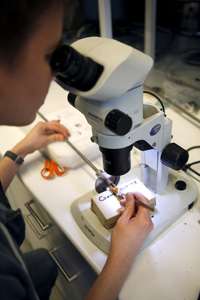Improved thermoelectric materials with atomic layer deposition

Researchers at the Aalto University School of Chemical Technology have applied atomic layer deposition (ALD) technique to the synthesis of thermoelectric materials. Converting waste energy into electricity, these materials are a promising means of producing energy cost-effectively and without carbon dioxide emissions in the future.
Using atomic layer deposition, thin films of approximately 100 nm in thickness were synthesised from zinc oxide, a well-known thermoelectric material. Aluminium or phosphorus was also added to the zinc oxide thin films at low concentrations, which improved the thermoelectric properties of the material without changing its crystal structure.
The synthesis method was well-suited for thin film growth processes requiring particular precision. In future, it can be used to fabricate different nanostructures to improve the material's thermoelectric properties even further.
'The simultaneous optimisation of different thermoelectric properties, such as thermal and electrical conductivity and Seebeck coefficient, is challenging because an improvement in one property typically leads to deterioration in another. But nanostructures produced by the atomic layer deposition technique will help us overcome this problem,' explains Tommi Tynell, a doctoral candidate.
Electricity out of waste heat in houses
Generators based on thermoelectric phenomena are simple and reliable devices that are also suited to awkward spaces. The materials used in their modules do all the work converting thermal energy into electricity.
In the future, they could be used for instance in residential buildings where, when installed into walls, they may convert heat into electricity. In vehicles, thermoelectric generators may help reduce fuel consumption. If a generator manufactured from thermoelectric materials is installed near a human body, it converts the heat generated by the body into energy.
Thermoelectric materials have already been applied for example to the manufacture of camping refrigerators. New materials, however, need to be developed because the current ones are expensive as well as somewhat toxic.
Two research papers have recently been published on the topic in the scientific publications Journal of Materials Science and Journal of Vacuum Science and Technology A.
Provided by Aalto University


















